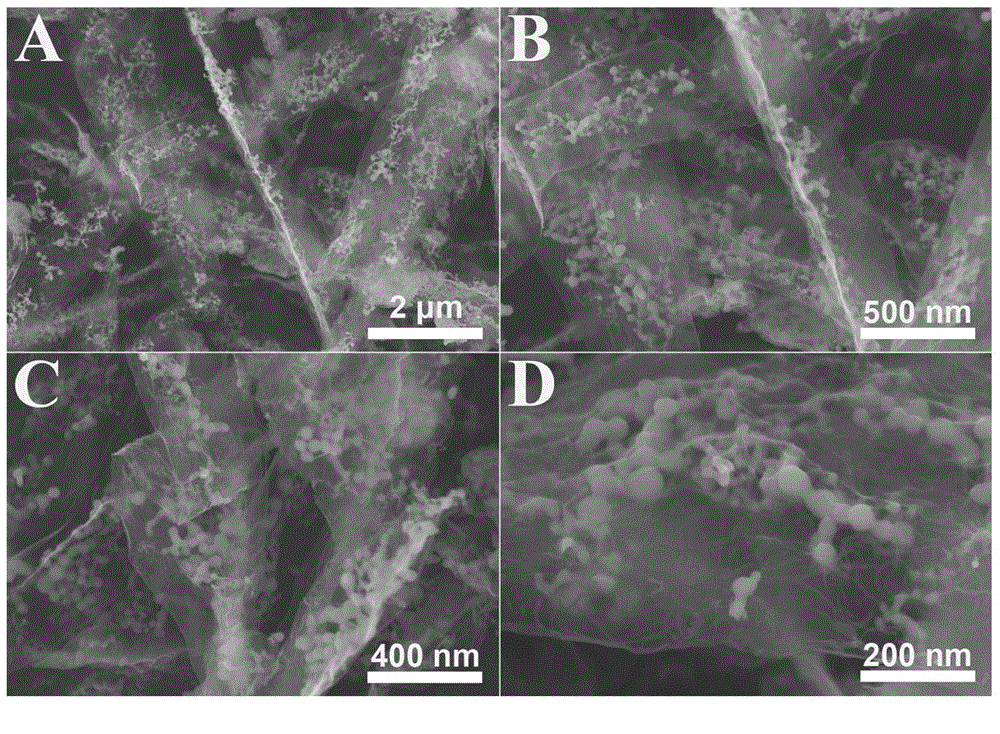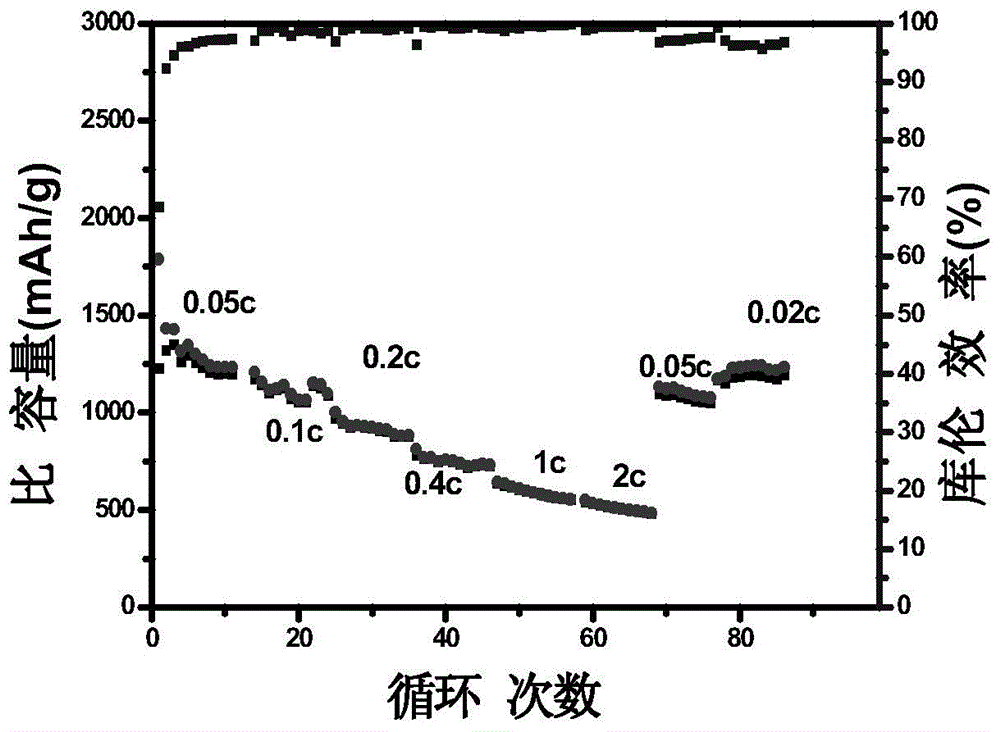Preparation method of graphene-carbon nanotube aerogel supported nano-silicon composite electrode material
A technology of carbon nanotubes and composite electrodes, applied in battery electrodes, circuits, electrical components, etc., can solve the problems of loss of electrical contact, poor conductivity, volume change, etc., and achieve the effects of increasing contact, improving conductivity, and increasing specific capacity
- Summary
- Abstract
- Description
- Claims
- Application Information
AI Technical Summary
Problems solved by technology
Method used
Image
Examples
Embodiment 1
[0032] 1) Preparation of graphite oxide:
[0033] Get 10g (8000 order) natural flake graphite and 500ml mass concentration be 98% sulfuric acid after mixing uniformly, add 10.0g potassium nitrate, add 60g potassium permanganate rapidly in the water bath of 15 ℃, mix uniformly. Then the temperature of the system was raised to 40°C, reacted for 3h, then added 300ml of water, and simultaneously the system was heated to 80°C for 30min, then the excess potassium permanganate was reduced with 500ml of distilled water and 100ml of hydrogen peroxide (30wt%), and centrifugally washed to The pH was 5, and the graphite oxide solid was obtained by vacuum drying at 40°C.
[0034] 2) preparation of graphene oxide aqueous solution:
[0035] Weigh 30 mg of graphite oxide solids and disperse them in 300 ml of water to prepare a graphite oxide suspension with a mass concentration of 0.1 mg / ml. Ultrasonic the suspension for 0.5 h at a frequency of 20 kHz to achieve single-layer peeling and obta...
Embodiment 2
[0041] 1) Preparation of graphene oxide aqueous solution:
[0042] Weigh 30 mg of the graphite oxide solid prepared in Example 1 and disperse it in 30 ml of water, and prepare a graphite oxide suspension with a mass concentration of 1 mg / ml, and ultrasonicate the suspension for 1 h at a frequency of 20 kHz to realize single-layer peeling, and obtain Uniform and stable graphene oxide dispersion.
[0043] 2) Preparation of nano-silicon composite electrode materials supported by graphene and carbon nanotube airgel:
[0044] 60 ml of 1 mg / ml nano-silicon dispersion and 5 ml of 1 mg / ml multi-walled carbon nanotube dispersion were prepared respectively, and 0.5 mg of sodium dodecylbenzenesulfonate was added to the carbon nanotube dispersion. At a frequency of 30 kHz, the two dispersions were ultrasonicated for 2 h to uniformly disperse nano-silicon and carbon nanotubes. Then add the dispersed nano-silica powder solution and carbon nanotube solution to 30ml1mg / ml graphene oxide sol...
Embodiment 3
[0048] 1) Preparation of graphene oxide aqueous solution:
[0049] Weigh 30 mg of the graphite oxide solid prepared in Example 1 and disperse it in 15 ml of water, and prepare a graphite oxide suspension with a mass concentration of 2 mg / ml. The suspension is sonicated for 2 h at a frequency of 40 kHz to realize single-layer peeling, and obtain Uniform and stable graphene oxide dispersion.
[0050] 2) Preparation of nano-silicon composite electrode materials supported by graphene and carbon nanotube airgel:
[0051] Prepare 30ml of 2mg / ml nano-silicon dispersion and 7.5ml of 2mg / ml single-wall and multi-wall carbon nanotube dispersion respectively, and add 0.3mg of cetyltrimethylammonium bromide to the carbon nanotube dispersion. At a frequency of 40 kHz, the two dispersions were ultrasonicated for 3 h to uniformly disperse nano-silicon and carbon nanotubes. Then nano-silica powder solution and single-wall, multi-wall carbon nano-carbon nanotube solution are added to the gra...
PUM
 Login to View More
Login to View More Abstract
Description
Claims
Application Information
 Login to View More
Login to View More - R&D
- Intellectual Property
- Life Sciences
- Materials
- Tech Scout
- Unparalleled Data Quality
- Higher Quality Content
- 60% Fewer Hallucinations
Browse by: Latest US Patents, China's latest patents, Technical Efficacy Thesaurus, Application Domain, Technology Topic, Popular Technical Reports.
© 2025 PatSnap. All rights reserved.Legal|Privacy policy|Modern Slavery Act Transparency Statement|Sitemap|About US| Contact US: help@patsnap.com



